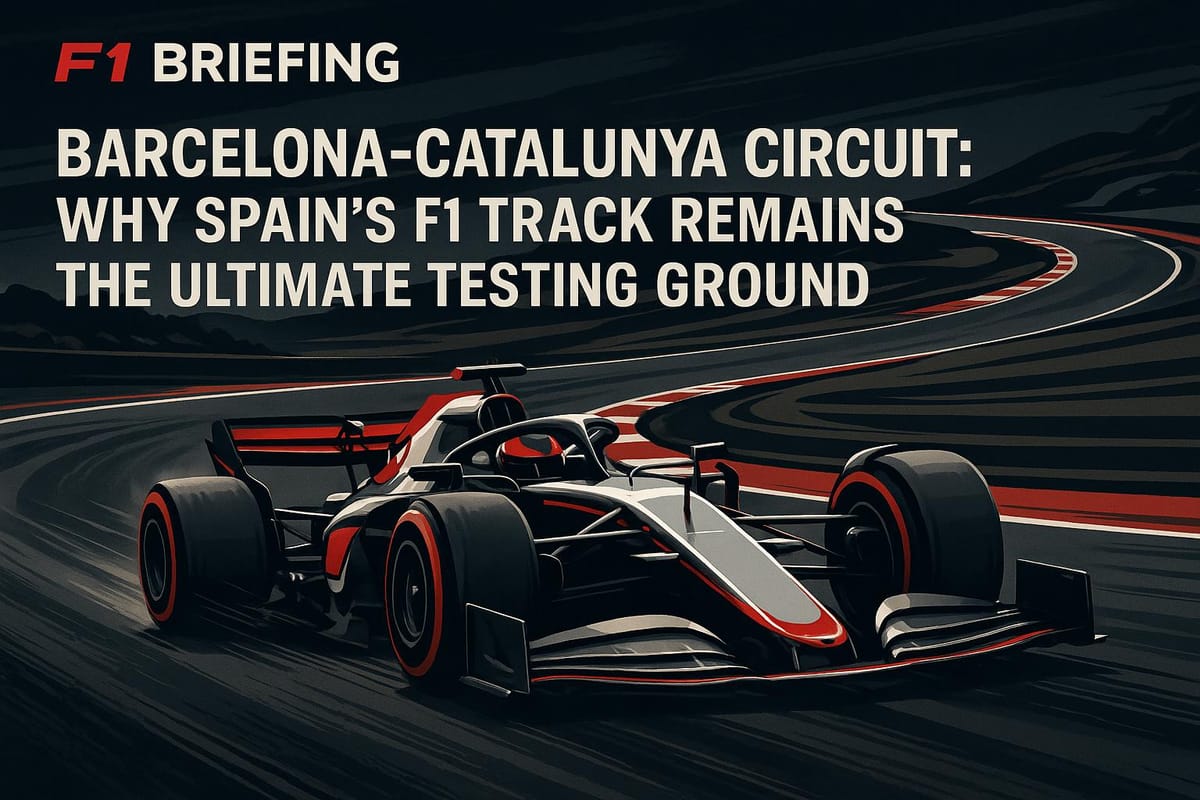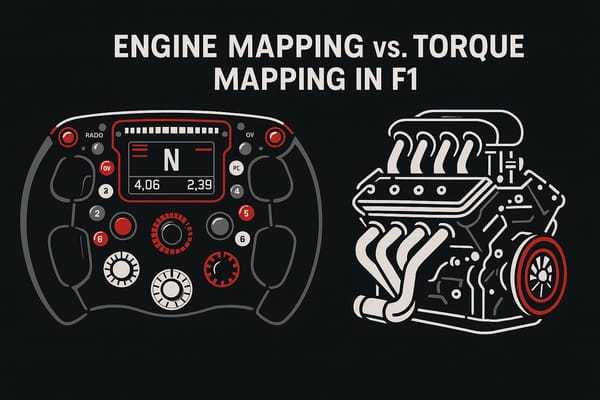Barcelona-Catalunya Circuit: Why Spain’s F1 Track Remains the Ultimate Testing Ground
The Barcelona-Catalunya Circuit is crucial for F1 teams, offering a unique testing ground to refine cars and shape season strategies.

The Circuit de Barcelona-Catalunya isn’t just a race track - it’s Formula 1’s ultimate testing hub. With its 2.9-mile layout, diverse corner types, and year-round favorable weather, it offers teams a perfect environment to fine-tune their cars. From aerodynamics to tire performance, every lap here provides critical data that shapes F1 strategies and car development.
Why Barcelona Stands Out:
- Track Variety: Combines fast straights, sharp turns, and elevation changes to test all aspects of car performance.
- Weather: Dry, stable Mediterranean climate ensures uninterrupted testing.
- Driver Familiarity: A well-known track that allows teams to focus on performance rather than learning the layout.
- Technical Challenges: Tests aerodynamics, mechanical grip, and tire wear, providing a complete performance picture.
Teams use data from Barcelona to identify weaknesses, prioritize upgrades, and prepare for the season. It’s no surprise that success here often predicts championship performance.
Barcelona F1 test: Ferrari’s experimental approach to strengthen correlation; Lewis Hamilton crashes

Key Features That Make Barcelona the Top Testing Ground
Barcelona stands out as the ultimate testing ground for Formula One teams, thanks to its diverse layout, reliable weather, and the technical challenges it presents. These elements allow teams to fine-tune every aspect of car performance before the season begins. Let’s break down the key factors that make this circuit so valuable.
Track Layout and Sector Variety
The Barcelona circuit, stretching 2.9 miles, is a microcosm of Formula One performance. With 16 corners that include everything from high-speed sweepers to sharp hairpins, along with extended straights, this track pushes teams to evaluate every performance factor during testing sessions. Its mix of corner types provides a unique opportunity to uncover weaknesses across various performance areas - all in a single session.
Weather Conditions and Year-Round Testing
Barcelona’s Mediterranean climate offers a stable environment for testing, especially during pre-season in late February. Teams can count on average high temperatures around 57°F (14°C) and mostly dry conditions. This consistency reduces the risk of unpredictable factors interfering with test results, allowing teams to make meaningful performance comparisons.
Technical Demands on Cars and Drivers
Barcelona isn’t just a test of the car - it’s also a test of the driver. The circuit challenges cars in areas like mechanical grip through its slower corners and aerodynamic efficiency in its high-speed sections, making it a true litmus test for car design. Aerodynamics play a particularly crucial role here. With just 61% of the lap spent at full throttle and engines operating primarily in the mid-rev range, teams focus heavily on aerodynamic balance rather than outright power.
Fernando Alonso highlighted the precision required in high-speed sections, saying:
"The circuit has many fast corners where good aero performance is necessary. Turn 9 is a good example as the right-hand turn is taken in 5th gear at about 230km/h. Precision is key, and it's crucial not to make any mistakes on the exit."
The track’s abrasive surface and numerous high-speed corners also serve as a proving ground for tire performance. Teams can analyze tire degradation, thermal behavior, and compound performance - critical data for developing race strategies.
The technical challenges extend to the final sector, where traction and mechanical grip take center stage. Nelson Piquet once noted:
"The end of the lap used to be a fast sector but with the introduction of the chicane two years ago, this sector is now slow requiring good mechanical grip and traction. It is particularly important to have a good exit from turn 15 because it immediately leads to the final corner and onto the last one-kilometer-long straight."
This blend of aerodynamic, mechanical, and traction challenges ensures that teams leave Barcelona with a thorough understanding of their car’s strengths and weaknesses. It’s no wonder the circuit remains an essential part of Formula One’s development process.
Sector-by-Sector Breakdown of the Circuit
Each sector of the circuit pushes Formula 1 cars to their limits in unique ways, providing teams with essential data for refining performance. These distinct challenges mimic real-world race conditions, helping teams prepare for the season ahead. Here's a closer look at how each sector plays a role in car development.
Sector 1: High-Speed Aerodynamics
Sector 1 kicks off on the main straight, which includes a DRS zone, before diving into a swift right-left corner sequence. This part of the track is all about high-speed aerodynamics and straight-line stability. Drivers tackle the opening corners at around 112 mph (180 km/h), enduring intense braking forces of approximately 275 lbs (125 kg) and experiencing deceleration at 4.1 G.
Turn 3 is the standout feature here. It's a fast right-hander where cars accelerate to about 177 mph (285 km/h) on exit. Aerodynamic load is critical in this section - cars with better downforce can generate more lateral G-force, allowing them to carry higher speeds through corners like this. The data collected from Sector 1 helps teams fine-tune aerodynamics, brake cooling systems, and overall stability.
From here, the focus shifts to mechanical grip and precision in Sector 2.
Sector 2: Mechanical Grip and Mid-Speed Challenges
Sector 2 emphasizes mechanical grip and chassis balance over raw aerodynamic performance. This section features mid-speed corners and elevation changes, demanding precise suspension and tire setups. Cars navigate corners at speeds ranging from 81 to 93 mph (130–150 km/h), where mechanical grip becomes the defining factor. Without sufficient grip, cars can lose valuable time and become difficult to handle.
Recent design changes have slightly reduced speeds in key corners. For instance, Turn 3 now averages 140 mph compared to 149 mph in 2021, while Turn 9 averages 155 mph versus 165 mph in 2021. These adjustments make suspension tuning and tire pressure even more critical. Teams rely on data from Sector 2 to refine these elements and achieve the right chassis balance, which is essential for tracks where mechanical grip takes precedence. This sector's insights are instrumental in preparing cars for diverse race conditions.
Sector 3: Traction and Low-Speed Precision
The final sector tests low-speed performance, traction, and driver precision. In 2023, the removal of the final chicane shortened this section by 59 feet (18 meters), creating a smoother flow that reduces the strain on tire traction. However, the updated layout introduces new challenges, particularly with a quick right-hander and a faster Turn 14, which place extra stress on left-hand tires.
Former Renault F1 driver Jolyon Palmer highlighted the impact of these changes:
"The previous final sector was not a pleasure to drive. You had to balance your tyre performance in the first and final sector, it felt really slow, and you squirmed your way around the final chicane trying to compete the lap. But that's all gone for 2023."
This sector isn't just about lap times - it plays a key role in race strategy. Teams analyze data from Sector 3 to manage tire wear, optimize traction control, and fine-tune low-speed aerodynamic balance. For example, during the 2024 Spanish Grand Prix, Charles Leclerc excelled in Sectors 1 and 2 but lost nearly two-tenths of a second to teammate Carlos Sainz in Sector 3 due to tire overheating and multiple corrections at a critical corner. These insights are crucial for developing tire management strategies and ensuring consistent race-day performance.
How Teams Use Barcelona Data to Shape Their Season
Barcelona testing plays a key role in shaping F1 teams' strategies for the season. The track offers a unique testing ground, reflecting the challenges of about 60% of the F1 calendar. By connecting testing data with race-day results, teams can focus on making targeted upgrades that enhance their performance.
Connection Between Testing and Race Performance
Barcelona's track is a standout predictor of car performance across the season. Its 4.657 km layout, featuring 14 corners, mirrors the demands of many circuits on the calendar. Teams use this track to evaluate crucial performance metrics, such as aerodynamic efficiency and tire management under high temperatures. These insights are vital for building a competitive baseline.
Interestingly, since 2017, every winner of the Spanish Grand Prix has gone on to win that year's constructors' championship. Max Verstappen highlighted the track's importance by saying:
"Of course, more and more street circuits are coming but it does show that if you're quick here, your car in general is still good."
This reinforces Barcelona’s reputation as a benchmark for overall car competitiveness.
Finding Weaknesses and Development Priorities
Barcelona's challenging nature exposes a car's strengths and weaknesses, making it a goldmine for setting development priorities. Engineers analyze sector data to pinpoint issues in areas like aerodynamics, mechanical grip, and power unit performance. Red Bull's Christian Horner emphasized the importance of strategic upgrades:
"It's all about iterations and of course you have to look very carefully where you bring your upgrades through the year."
Specific sections of the track provide even deeper insights. For example, Turn 3 is a critical test of high-speed aerodynamic performance, while the mid-speed corners highlight mechanical grip deficiencies. This granular data helps teams differentiate between quick fixes and long-term upgrades.
Moreover, Barcelona’s demands ensure no car can hide its flaws. The reliable data from this track allows engineers to focus on upgrades that deliver measurable gains across a variety of circuits. Ultimately, the insights gained here help shape strategies that can make or break a team's season.
Conclusion: Why Barcelona Remains Important to Formula One

The Barcelona-Catalunya Circuit has firmly established itself as the go-to testing ground in Formula One. Its significance lies in its ability to provide teams with a thorough evaluation platform, allowing them to test everything from aerodynamics to mechanical grip - all in one place.
Barcelona’s location in Europe makes it ideal for quick parts delivery, while its typically dry weather ensures minimal disruptions to testing schedules. The track's challenging layout exposes every car's strengths and weaknesses, making it a reliable measure of performance.
"It's a proper race track, and this is where a Formula One car comes alive." – Max Verstappen
Teams rely on the insights gained here to fine-tune their strategies for the entire season. The circuit’s abrasive surface, which causes high tire wear, also provides valuable data for race strategy testing. Decades of testing history at Barcelona give teams a wealth of comparative data to guide their development efforts.
Even as Formula One embraces new venues worldwide, the Barcelona-Catalunya Circuit remains unmatched as the sport's premier testing hub. Its role in shaping championship strategies through rigorous, data-driven testing is as crucial as ever.
FAQs
What makes the Circuit de Barcelona-Catalunya the ideal testing ground for F1 teams?
The Circuit de Barcelona-Catalunya is often seen as the perfect testing ground for Formula One teams, thanks to its well-rounded track design. Its layout offers a mix of high-speed straights, sharp low-speed corners, and elevation changes, giving teams the chance to evaluate their cars across various performance aspects. From aerodynamics and tire wear to overall handling, the circuit challenges every critical element that can influence success throughout the season.
What makes this track even more ideal is its reliable weather during pre-season testing, which ensures teams can gather consistent and dependable data. The relatively short lap length also works in their favor, allowing for efficient data collection and more opportunities to refine strategies and setups. This blend of technical variety and practical benefits makes the Circuit de Barcelona-Catalunya a key venue for preparing both cars and drivers for the grueling F1 season ahead.
What makes the Barcelona-Catalunya Circuit so important for car development and race strategies in Formula 1?
The Barcelona-Catalunya Circuit holds a key spot in Formula 1, thanks to its demanding and diverse track design. With a mix of fast corners, tricky low-speed turns, and a lengthy main straight, it offers teams an ideal testing ground to assess aerodynamics, mechanical balance, and overall car performance across a range of conditions.
What sets this track apart is its notorious tire wear, pushing teams to fine-tune their tire management and pit stop strategies. This unique challenge helps teams gauge how their cars handle extended runs, preparing them for the rigors of a full F1 season. By exposing both the strengths and flaws in car setups, the circuit serves as a true litmus test for performance and readiness.
How does Barcelona's weather impact Formula 1 pre-season testing?
Barcelona's weather plays a crucial role in the success of Formula 1 pre-season testing. In early spring, temperatures typically range from 68–77°F (20–25°C), creating ideal conditions for assessing tire performance and fine-tuning car setups. These mild temperatures allow teams to gather consistent data on tire wear, grip levels, and the overall behavior of their cars.
What makes the region even more suitable is its generally stable weather. With minimal disruptions from rain or extreme conditions, teams can stick to their testing schedules without major interruptions. This reliability makes the Barcelona-Catalunya Circuit a top choice for pre-season testing, providing teams with the perfect environment to prepare for the challenges of the racing season ahead.




